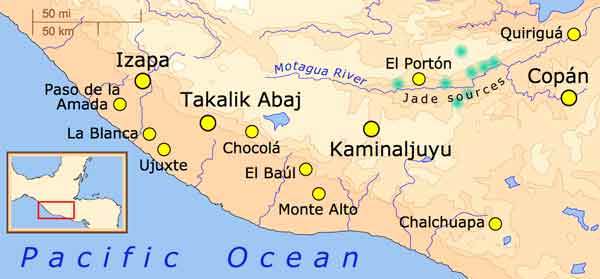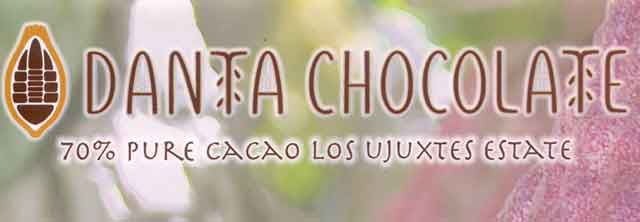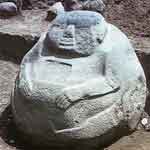 GEN’L FLAVOR PROFILE: big & bold; very volcanic with high fruits
GEN’L FLAVOR PROFILE: big & bold; very volcanic with high fruits
GEN’L CHARACTERISTICS: few remaining Criollo relics mostly crossed with Ecuador Nacional, and Amelonado probably sourced from Martinique for a mix that locals generally describe as pre-1979 Costa Rica Matina.
Fabled heartland of ancient Mayan cities at whose height, around 750AD, teemed with several million people – perhaps the most densely populated area on Earth at the time – & home to the “chocolate potbelly” of Theobroma cacao… seminal & venerable / sought-after & fought-over
Cacáo’s venerable history still holds considerable importance right up thru to the present.
A defining quality of the Mayan cosmo-vision is a cross-media, sensual dimension that animates objects, landscapes, myths, dieties… in reality everyday life. For the Maya, the world was a transformational, multi-sensory place, governed by analogic reasoning where all senses – sight, scent, touch, hearing & taste – merged in what Houston & Taube call ‘cultural synaesthesia’. Set within landscapes they conceived as sacred, substances such as jade attracted moisture thru magnetic force, bestowing greenery & fertility to the fields surrounding it. Similarly, turquoise, the property of the gods, was believed to emit smoke, while quetzal feathers symbolically linked them to rulers. And cacáo with its association of heart ‘n blood would literally course thru the arteries of trade networks as a from of currency.
As recently as the early 1900s, it continued to circulate as a form of currency here. Even today cacáo solemnizes weddings, birth rites, Spring fertility festivals, healing ceremonies & generalized cofradías (brotherhood). It especially retains sacredness during Easter — its association with “re-born again” ancestors now transferred to the crucifixion on which cacáo resuscitates the Christ.
Ethno-archeo-botanist Prof. Cameron McNeil believes contemporary ritualistic use of cacáo in places like Santiago Atitlan near the Pacific Coast are survivors of Pre-Columbian traditions & one of the reasons the Guatemalan army targeted them during the Civil War of the 1970/80s. The army murdered countless non-combatants – operating on an unofficial policy ‘if it’s brown, take it down’ – out of fear that they (perhaps correctly) sympathized with leftist guerrillas insurgents. Their human rights abuses were brought to sensationalized light by the Nobel Laureate Committee’s favorite indigenous godmother of historical-fiction – Rigoberta Menchú, a K’iche’ Maya with a violent warrior tradition of their own.
Whatever one makes of her account bending the truth toward inaccuracies, it at least constitutes a loose testimonio generally based on fact. Atrocities largely perpetrated by the Guatemalan Army &, in all fairness, to a lesser extent the armed resistance by what became the unified UNRG, remain undeniable. To cite but one example, the 1982 guerilla ambush of a govt convoy followed by the massacre at Dos Erres where highly-trained special ops forces – the Kaibiles – disguised as a guerilla column, “vaccinated” residents with extreme prejudice.
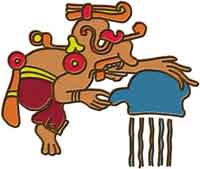 In the aftermath, governmental paramilitaries prohibited gauro clandestino — an outlaw alcohol made from fermented cacáo (think Appalachian moonshine). They also banned rainmakers in the agrarian cults on the eastside of the country who call on the Chaacs (rain-gods, shown left) in offering cacáo… still a dangerous business conducted only in secret.
In the aftermath, governmental paramilitaries prohibited gauro clandestino — an outlaw alcohol made from fermented cacáo (think Appalachian moonshine). They also banned rainmakers in the agrarian cults on the eastside of the country who call on the Chaacs (rain-gods, shown left) in offering cacáo… still a dangerous business conducted only in secret.
Today, choco-hounds count their lucky blessings if they can find in this bio-diverse hotspot any Acriollizado – a Criollo half-breed caught up in the intrusions, the blights, & the recent opportunity costs that pay growers more for bananas & rubber than cacáo.
And now another scourge blankets the countryside: the feared Maras drug cartel roaming from Guatemala to California.
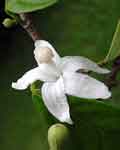 The once-fabled cacáo-groves along the Pacific mostly count backyard ornamentals pruned at the household level for small local markets. What little exists centers around the area of San Antonio Suchitepéquez – considered the heart of the prime cacáo-growing zone. A couple major towns then press the beans into chocolate tablets resembling pancakes, way more sugar than cocoa, as they’ve done for over 100 years. Gone too: the traditional spices such as ear-flower & Quararibea funebris (shown right) in favor of cinnamon. In a total twist, the admixture requires the original inditos (supposedly “uncivilized”) to teach the civilizados (so-called “civilized” converts) their lost art.
The once-fabled cacáo-groves along the Pacific mostly count backyard ornamentals pruned at the household level for small local markets. What little exists centers around the area of San Antonio Suchitepéquez – considered the heart of the prime cacáo-growing zone. A couple major towns then press the beans into chocolate tablets resembling pancakes, way more sugar than cocoa, as they’ve done for over 100 years. Gone too: the traditional spices such as ear-flower & Quararibea funebris (shown right) in favor of cinnamon. In a total twist, the admixture requires the original inditos (supposedly “uncivilized”) to teach the civilizados (so-called “civilized” converts) their lost art.
Intensive cacáo-groves, known in Mayan as pakal, tilled in centuries past & still found as part of a forest-garden ecology feature highly diverse, integrated flora & fauna that produce abundant staples & natural resources. This system compares quite favorably to modern agribiz with its heavy reliance on petrochemical fertilizers & pesticides. Pakals can yield roughly 400kg from 600 cacáo trees per hectare on average, versus the monocrop equivalent on early 21st century African “sun plantations” of 300-400kg. The new breed of super-seeds hopes to surpass that by double or even treble. For instance Paul Manickchand’s HDP (High Density Planting) estate in Trinidad, also a monoculture operation, has 1,000 trees per hectare, or one every 6 feet.
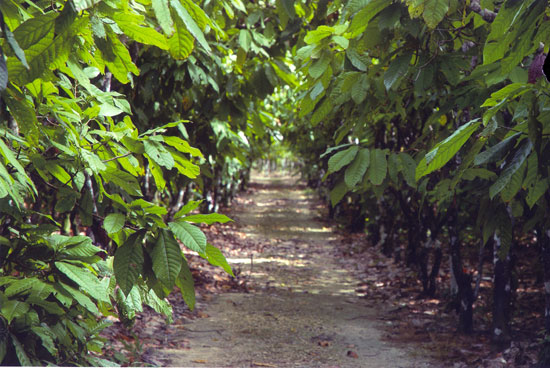 Sangre Grande Estate, Trinidad (Paul Manickchand)
Sangre Grande Estate, Trinidad (Paul Manickchand)
The cacáo-chronicler Preuss in 1901 probably witnessed some pakals when he saw only white cotyledons on the cacáo trees along his tour of the area – a sign that the older varieties were holding their own. By 1961 when Soria visited, the situation had changed. The introduction of an Amelonado-type at the hands of the UFC (United Fruit Company, chief sponsor along with the CIA of the coup engineered by a military junta in 1954), probably sourced from Martinique, rampantly crossed with the few remaining Criollo. A similar development occurred in Mexico with a genotype known as ‘Ceylon’, and Costa Rica with ‘Matina’, so that today people generally describe Guatemala’s gene stock as mostly pre-1979 Costa Rica “Trinitario” – that generic one-size-fits-all mob term.
With it came a new wave of diseases.
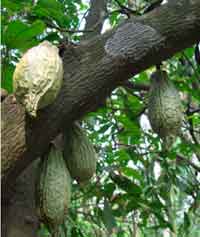 Even when Bernoulli surveyed Guatemala way back in 1869, the aboriginal varieties were already in decline however. Shifting trends & fortunes crippled the chocolate industry as café culture proliferated & coffee bushes overran cacáo trees. Before the introduction of cacáo varieties from the outside, Bernoulli sketched the variability of cacáo among 3 types — 1) Classic; 2) Leiocarpa (smooth husks without prominent ridges); & 3) the 5-ribbed Pentagonum (shown left) — all belonging to the Criollo family.
Even when Bernoulli surveyed Guatemala way back in 1869, the aboriginal varieties were already in decline however. Shifting trends & fortunes crippled the chocolate industry as café culture proliferated & coffee bushes overran cacáo trees. Before the introduction of cacáo varieties from the outside, Bernoulli sketched the variability of cacáo among 3 types — 1) Classic; 2) Leiocarpa (smooth husks without prominent ridges); & 3) the 5-ribbed Pentagonum (shown left) — all belonging to the Criollo family.
In response to dwindling production, Guatemala reluctantly sanctioned the importation of “heartier” Ecuador Nacional (Guayaquil) in order to resuscitate its cacáo groves in 1861 after decades of resisting it. The ensuing new population of hybrids would resemble Ecuador’s after that country brought in ‘Venezolano’ types from 1890 onwards in the wake of its own scourge.
In effect, Guatemalan cacáo suffered the worst of both worlds: losing its heritage cacáo only to be supplanted by a varietal – Nacional – that, like wine grapes, travels poorly, rarely if ever carrying any of its famed florals along for the trip.
As elsewhere in Mesoamerica, this recurring pattern of declining cacáo harvests goes all the way back to the early Colonial period. By the mid-1600s production became acutely insufficient even for local markets. Reasons for this are complex & overlapping, ranging from overproduction that led to exhaustion; over-taxation which sapped motivation; & diseases among the human population like smallpox, measles & influenza carried by Europeans that wreaked havoc on Amerind immune systems precipitating a catastrophe that dried up the labor pool to pick the crop. Add fierce resistance to Spanish rule into the mix — especially in Guatemala’s northern lowlands revolving around Petén – and disaster proved inevitable all the way around.
The few Amerind communities to escape total extinction refused, understandably, to be subjugated into working on lands growing & harvesting cash crops for foreign invaders who tried to coerce them using harsh forced-labor terms called encomienda. Equally bad, they were prevented from tending to crops vital for survival & their own sustenance – a ‘lose-lose’ situation. In their eyes, why should they become slaves to their own wealth?
Even if the people who coveted cacáo for centuries wanted to work, the climate & soil conditions wouldn’t allow for it. Fewer trees, feeble at that, brought sparse production.
Perhaps a fitting if sad state of affairs for cacáo was so intensely valued & venerated in these parts it caused conflicts & wars pre-dating the Spanish.
Back then Petén centered the heartland of the Classic Maya (200CE-900CE), home to the Itza (literally ‘magic-water’ / itz = magic, (h)á=water). The last Mayan kingdom in Mesoamerica to holdout against the Spaniards, the Itza fought an aggressive insurgency campaign – protected in large measure by surrounding jungle – until the fall of its Canek dynasty on the island city of Lake Petén Iztá which they called Noh Petén (their sacred capital known variously as Tayasal or Tah Izta [literally ‘place of the Itza’]). It lies under modern-day Flores, Guatemala. The city fell on March 13, 1697 – almost 175 years after Cortés initial entrada (foray) into the region in 1525 that ultimately ended in conquest. Their struggle persisted & in some ways shifted to the Yucatán peninsula on the Mexican Caribbean where the dream of a Maya Free State continues to this day. Whether in the Zapatista Movement of Chiapas, or the memory of Chan Santa Cruz, or texts such as the Chilam Balam cobbled together as a recension from various sources, the Maya endure… despite all the sabotage over the centuries by the Spanish, Mexicans, British, & Americans.
When Cortés passed thru the area, their ruler Ahau Canek told him about the kingdom’s prized cacáo orchard around Nito (on the coast right in the corner of the Bay of Honduras today; a plausible source for the very first cacáo that Europeans spotted earlier onboard a Chontál-Maya canoe during Columbus 4th Voyage in 1502 off the Bay Islands).
Lacking gold or silver, the conquistadores largely bypassed the region.
During that interval between Columbus & Cortés of a couple decades, the Itza turned the subjugation of their neighboring rivals by the Spanish into their own advantage. Following a Mesoamerican dynamic dating back centuries, every border state became a hotbed of political intrigue as each sought to manipulate shifting political fortunes.
Similar to the Mexìcâ (Aztec) who lived in the arid central highlands & waged war to their south in order to capture Xoconusco’s hallowed cacáo-groves, the Itza’s own lands were infertile & unsuitable for cacáo cultivation. So they conducted trades & raids depending on whichever proved convenient for what they most desired: cacáo, vanilla & achiote — with cacáo first among equals. The Itza forged political alliances, sealed social arrangements & closed business deals with a toast of it since they valued cacáo as good as gold & trusted it more than any signature on a treaty. They also glorified it in their iconography.
Almost everywhere & always, art symbolizes the highest aspirations &/or deepest insights of people. The earliest known vessels inscribed with cacáo glyphs dating from no later than 250CE come from this area. Their style & elaboration on such ceramic crafts further elevates cacáo’s importance.
In Mayalands, then later among the Mexìcâ (Aztec) court & European aristocracy, cacáo belonged primarily to the realm of ah yikales, the upper class merchants who controlled the luxury goods market. They as well as their rich & powerful clients paraded their conspicuous consumption, endowing them with prestige – the Hollywood fame-game of its day.
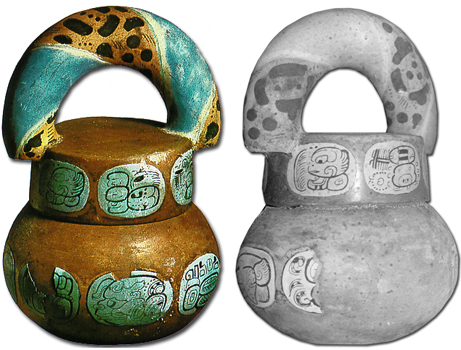 “The Chocolate Pot” – the Rosetta Stone of cacáo – recovered by REW Adams during an excavation in 1984 inside Tomb 19 at Rio Azul (Guatemala; its Mayan name ‘Sak Há Witznal’ meaning ‘Clear Water Mountain’); a lock-top vessel dating to circa 455 – 465 CE. Vessels were labor-intensive arts & crafts; among the most important valuables a Mesoamerican owned, stamped with their personal insignia. The Chocolate Pot’s historical magnitude resides in: a) first vessel analyzed with ancient cacáo residue; b) Mayan glyphic inscription proclaiming its contents of two types of cacáo (one perhaps being Theobroma bicolor?); & c) pure prima facie beauty.
“The Chocolate Pot” – the Rosetta Stone of cacáo – recovered by REW Adams during an excavation in 1984 inside Tomb 19 at Rio Azul (Guatemala; its Mayan name ‘Sak Há Witznal’ meaning ‘Clear Water Mountain’); a lock-top vessel dating to circa 455 – 465 CE. Vessels were labor-intensive arts & crafts; among the most important valuables a Mesoamerican owned, stamped with their personal insignia. The Chocolate Pot’s historical magnitude resides in: a) first vessel analyzed with ancient cacáo residue; b) Mayan glyphic inscription proclaiming its contents of two types of cacáo (one perhaps being Theobroma bicolor?); & c) pure prima facie beauty.
With the demise of the maritime power to the north — the Chontál-Maya — at the hands of the conquistadores, the Itza stepped in to leverage the factional fighting among various surviving Mayans — the micro spoils or crumbs in the wake of the macro Spanish conquest. They became the strongest / largest of the local indigenous groups. Every bit the opportunists as their ruthless Spanish opposites, Itza seized upon the fugitive network of runaway Manche Ch’ol, Lacandons, Mopans & Xocmoes fleeing the grasp of the Europeans, all settling into fertile valleys good for growing those coveted staples. By war, violence & intimidation, the Itza imposed solidarity. They’d just as soon traffic in slaves & eat their neighbors’ flesh than allow them to convert & consume the Christian Eucharist. With their source of wealth & power denied however when the Spanish gradually cut them off thru divide & conquer tactics from, first, the Manche Ch’ol, then, secondly, the Lacandon, leading to the decline of prosperous cacáo groves, the Itza soon fell prey to the devouring appetites of foreigners.
A fate the Itza would understand in a story re-played the world over from time immemorial.
They themselves must’ve emerged as the successors of a clash between regional superpowers Tik’al & Calakmul that may have precipitated the so-called “Mayan Collapse”.
Sworn arch-enemies, those rivals set up various client states – the Caracol & the predator state at Dos Pilas, for example – to vie for resources.
In Tik’al’s case, the need for external resources is partially explained by the absence of any nearby oceans, lakes, rivers, creeks, springs or mountain runoff that simultaneously highlight a prodigious feat: the residents at Tik’al built a major city nonetheless… fed by intensive agriculture irrigated by stored seasonal rainfall alone. Even more remarkable that they achieved such an abundance over much of what amounts to swampland.
The struggle for water in a seasonal desert where much of Maya civilization resided kept them on the edge of survival & helps define their cosmology that sought to transform their surroundings.
Notwithstanding, Calakmul defeated Tik’al in 562AD, heralding the Tik’al Hiatus — a date that subdivides the Early from the Late Classic periods in Mayan history.
In alliance with Caracol (now modern Belize), Calakmul occupied Tik’al & an ensuing crisis befell the city. Writing of inscriptions & large-scale construction virtually ceased there. For the next 50 or so years stelae (the Maya called them tetun, or “tree-stones”), which depict rulers along with hieroglyphic texts describing their genealogy, military conquest(s) & other landmark events, were defiled in a time-honored Mayan tradition of victors effacing the conquered. Additionally, the defeat apparently imposed upon the captured 21st Ruler of Tik’al – Wak Chan K’awiil (“Double Bird”) – a severe humiliation for any dynasty: he was clipped & hauled into bondage to his sacrificial burial grounds.
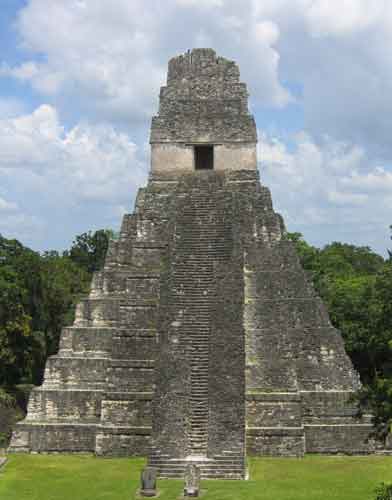 Payback came in 695CE when Tik’al exacted revenge under the celebrated Jasaw Chan K’awiil I a k a “Ah Cacao” whose funerary Temple Pyramid I also bears the nickname Ah Cacao. This event marks Tik’al’s resurgence of influence, exerting regional control all the way to Lake Itzá.
Payback came in 695CE when Tik’al exacted revenge under the celebrated Jasaw Chan K’awiil I a k a “Ah Cacao” whose funerary Temple Pyramid I also bears the nickname Ah Cacao. This event marks Tik’al’s resurgence of influence, exerting regional control all the way to Lake Itzá.
Most histories of the Petén region by the 8th / 9th centuries, notably by Arthur Demarest, describe a downward spiral of hostilities gripping the area, plowing it into a landscape of fear unimaginably similar to the one that would revisit the country during the Civil War of the 1970s.
Accounts of constant warfare, however, may be as exaggerated as proclaiming 21st Century America with her 1,000+ military bases around the world is in a state of perpetual conflict. Ditto any astrological forecasts that the death-star Venus, rising & in alignment, heralded ‘cease all art & play, it’s war-time’. Admittedly, Mayans designated certain levels of warfare as modern Americans do ‘terror alerts’. An “axe war” declared war ‘with intent to destroy’ & a “star war” equated with holy war or jihad, often planned according to astrological forecasts, with Venus in the pre-dawn sky an especially evil portent. The latter appears to be the sign that led Caracol to Calakmul in 562 to take Tik’al.
With or without endemic warfare, Tik’al’s hinterland population apparently began to heavily congregate close to the city itself, accelerating intensive agriculture & subsequent environmental decline. Deforestation & erosion exacerbated overpopulation & agrarian overproduction in a vicious cycle. Mega-droughts then may have had a cascading effect causing cultural upheaval in a feedback sort of loop of wars, invasions, peasant revolts, trade disruption, etc.
This is generally considered the cause of the “Mayan Collapse”.
It occurred unevenly, however, considering that Maya civilization continued on in the Yucatán & elsewhere, spreading out in no small way by sacbeob. In re-routing the critical cacáo trade from inland riverine traffic to coastal transit by merchant marines (mostly from Chichen Itza in the Yucatán), the Mayans mirrored Portuguese ships circumventing the Silk Road.
The plural form of sacbe (meaning ‘white way’ in Mayan after the color of their crushed stones), these raised stone causeways ran 2 to 6 meters (6 to 18 feet) above ground & measured from 20 to 50 meters wide (over some rugged landscape).
They trace back at least to El Mirador — a sprawling Mayan metropolis whose florescence from the 6th century BCE reached its peak about the 3rd century BCE to the 1st century CE with a population of perhaps more than 100,000.
According to Carlos Morales-Aguilar, a Guatemalan archaeologist, El Mirador appears to have been planned from its foundation. Extraordinary alignments have been found between the architectural groups & main temples, possibly related to solar alignments, reflecting the belief in urban planning & sacred spaces since its very first settlers.
El Mirador fascinates also for the quantity & size of its causeways, running thru the important plazas within the urban core & externally linking up major ancient cities around the larger Mirador Basin. One sacbe connected El Mirador to its neighbor Nakbé, a ceramic center 12km away; while another traveled 20km to El Tintal.
Who knows if any went all the way across the country… to the western highlands that started cacáo’s renown ultimately leading to a global phenom.
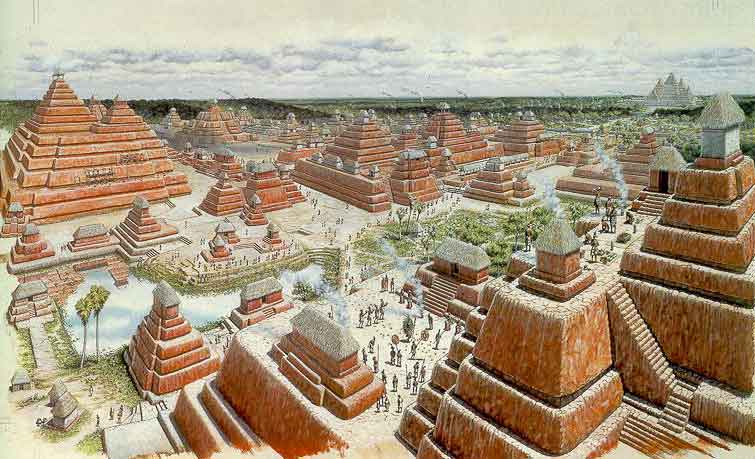 El Mirador… may be the most spectacular city ever built in the New World; artist’s conception based on the excavation team led by BYU archeologist Ray T. Matheny
El Mirador… may be the most spectacular city ever built in the New World; artist’s conception based on the excavation team led by BYU archeologist Ray T. Matheny
There, in the west, Guatemala contains the lion share or, considering the sacred significance of another cat widely held throughout the region, the ‘jaguar-share’ of a vitally important chain of revered cacáo groves in all of chocolate lore. Along the humid piedmont zone of the Pacific slope of southern Mesoamerica extending from Xoconochco (Soconusco) Chiapas in modern Mexico, south thru the prime growing zone in Guatemala (Suchitepequez, Mazatenango, Escuintla, Guazacapán) & onward to El Salvador, cacáo stood central — its worth in commerce & cosmology rivaled only by maize. It coincides & overlaps in many respects with the predominant distribution of ‘potbelly sculpture’ that appears around the Late Preclassic era (c. 200CE). As such Guatemala comprises the heart & guts for what might affectionately be termed the geographic ‘chocolate potbelly’.
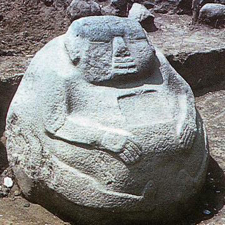 Many believe that cacáo culture here reached its zenith there & then… the Maya naturally selecting prized cultivars for their hi-flavor beans, bringing forth the finest cacáo ever cultivated on Earth. Quite possibly true insofar as Friar Francisco Ximénez, noted translator of the holy Mayan text Popul Vuh, inventoried the single-origin cacáos in the Americas, saying that the absolute best grew along this Pacific coast.
Many believe that cacáo culture here reached its zenith there & then… the Maya naturally selecting prized cultivars for their hi-flavor beans, bringing forth the finest cacáo ever cultivated on Earth. Quite possibly true insofar as Friar Francisco Ximénez, noted translator of the holy Mayan text Popul Vuh, inventoried the single-origin cacáos in the Americas, saying that the absolute best grew along this Pacific coast.
Over the centuries – millennia really – the Maya developed & refined chocolate craft. They planted for variety & diversity on a stunning scale – especially by modern standards. Each selection based on desirable traits & described by respective fruit colors: (ix sac [white], ix kan [yellow], ix chak [red], ix morado [purple], & even ix box [black]).
Legendary ancient cities abound throughout the region. These were ajawi in various stages of development – confined city-states or enormous royal households, hierarchically organized, headed by an ajaw (a king or queen) & grouped around a sacred center featuring teocalli s (temple pyramids). The greatest of them cultivated cacáo for its riches:
Chocolá (1,000BCE – 200CE) – the very epicenter perhaps, lying on a plateau below volcanic mountain ridges at 500-1000m in altitude; early signs of high complexity at Chocolá are attributed to intense cultivation of cacáo, irrigated by hydraulic water springs, for the lucrative long-distance trade circuit. Chocolá may have indirectly borrowed from the earlier non-Maya Izapa located up the coast at Xoconochco – an argument advanced by Yale Prof. Michael Coe in suggesting that the monumental stone-sculptors of Izapa form the connective tissue between the earlier Olmec & the later Maya that loosely links them together. If so, this represents a key development for the SMA (Southern Maya Area) &, plausibly, a seminal one in the rise of Classic Mayan civilization, architecture, city-states, hieroglyphic literacy, detailed ceramics & advanced math / astronomy.
Balberta (height 200AD – 400 AD) – hundreds of ceramic effigies depicting cocoa beans have been recovered here. Cacáo probably the city’s main export traded for, archeology evidence suggests, green Pachuca obsidian from far flung Teotihuacan in the distant northern Valley of Mexico which eventuated Balberta’s demise since Teotihucan became hostile & colonized the region.
Montana (c. 400CE) – replaces Balberta as the regional capital in the Early Classic period; founded as a colony by the great metropolis of Teotihuacan up north in order to supply that city with locally produced goods such as cacáo, cotton & rubber as well as for access to the trade routes that run between the great highland city of Kaminaljuyu (see below) & the Maya lowlands (see Petén above) across the Sierra Madre de Chiapas.
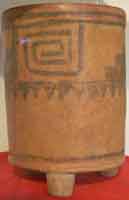 Tak’alik Ab’aj (1,000BC – 1,000 AD & beyond) – an important commercial, ceremonial & political center for both Olmec & Maya; famed for its Ocosito style ceramics (red paste & pumice). Tak’alik Ab’aj prospered from the production of cacáo & the consequent trade routes crisscrossing the region. The city featured a dozen or so plazas built up over 2.5 sq miles, one equipped with an astronomical observatory for sky-watchers, & several appointed with temazcalli (Nahuatl for ‘house of heat’) or sauna baths furnished by hydraulic stone-lined water channels, set within steep defensible ravines cut by natural & artificial terraces – a couple of them currently used for coffee & rubber plantations.
Tak’alik Ab’aj (1,000BC – 1,000 AD & beyond) – an important commercial, ceremonial & political center for both Olmec & Maya; famed for its Ocosito style ceramics (red paste & pumice). Tak’alik Ab’aj prospered from the production of cacáo & the consequent trade routes crisscrossing the region. The city featured a dozen or so plazas built up over 2.5 sq miles, one equipped with an astronomical observatory for sky-watchers, & several appointed with temazcalli (Nahuatl for ‘house of heat’) or sauna baths furnished by hydraulic stone-lined water channels, set within steep defensible ravines cut by natural & artificial terraces – a couple of them currently used for coffee & rubber plantations.
The K’iche’ overran the original residents around 1,000CE but even well after its peak at the time of the Spanish Conquest in the 16th century it was still prominent for cacáo.
In its heyday, Tak’alik Ab’aj served as a principle link in the trade network interfacing with…
… Kaminaljuyu (primarily occupied from 1500BC to 1200AD) – so named from a K’iche’ Mayan word meaning “mounds of the ancestors”; described as one of the greatest of all ancient American cities by Yale anthropologist Dr. Michael Coe (co-author of The True History of Chocolate). Although its primary source of wealth derived from chayal (Mayan for ‘volcanic glass’ known as obsidian), its strategic location between the Pacific coast / piedmont & the Maya Lowlands up north placed it ideally in the middle of a trade nexus for salt, fish & sea shells from the coast; cacao & other crops from the piedmont; jaguar skins, feathers, & more from the Lowland jungles – that underlay its reputation & influence throughout the Maya world.
Parts of Kaminaljuyu lie on a broad plain beneath modern Guatemala City – another reminder that great cities of today are built upon foundations of the past. And, per chance, the exact spot where cacáo’s fortunes may be revived. For right here, a local bar-smith, Carlos Eichenberger of Danta Chocolate, is putting Guatemalan back on the chocolate map, right in the center of its historical glory, where it rightfully belongs.





